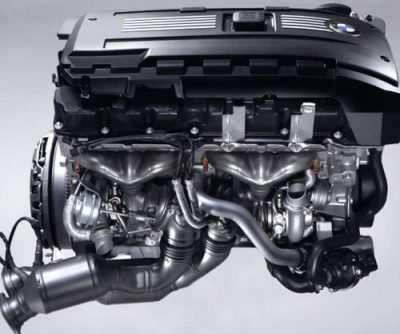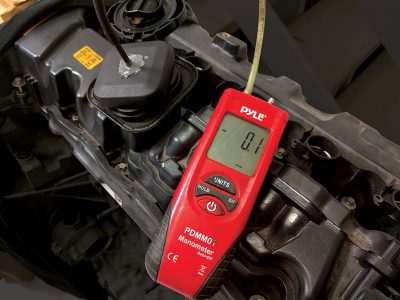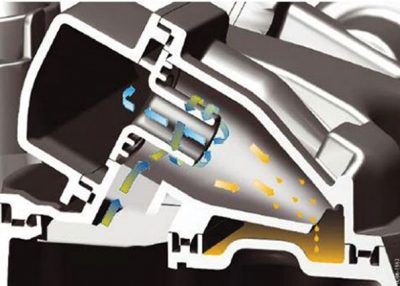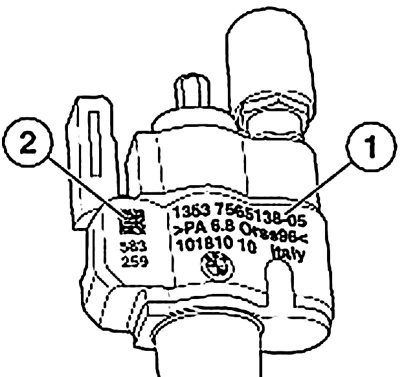The 3100 Boost Deactivation is one of the three most encountered diagnostic trouble codes (DTCs) for fuel mixture issues.
The BMW N54 engine which first appeared in the E92 335 coupe is a twin turbo direct injected engine. The HPI system can produce fuel pressures up to 2900 psi (200 BAR).
The engine uses two small low-pressure turbochargers to minimize turbo lag at low elevations. For this reason, the turbo pressure is only 8.8 psi since the engineering goal was to offer the same driving feel as with naturally aspirated engines. BMW’s brand for turbocharging is “TwinPower Turbo.â€
The three diagnostic trouble codes (DTCs) we encounter most often for fuel mixture issues are: 2e91 Mixture Control 2; 29e0 Mixture Control 1; and 3100 Boost Deactivation. For this 3100 code we should reference BMW TSB 12 28 07. This indicates that the code should be ignored if set with other codes. So now we are set to pursue the two mixture codes.
One of the first things we generally check on BMW motors is crankcase pressure.
We have to understand that, unlike other BMW engines, the n54 does not use a diaphragm for the crankcase ventilation system. Instead it uses four small cyclonic separators. While this arrangement can cause some air restriction and oil consumption when it malfunctions, rarely does it seem to cause fuel trim issues. The spec for the system is 17MB.
Next we should check for vacuum leaks using a smoke machine, typically in two areas — one via the oil cap, and the second by tee-ing into the vacuum ports on the vacuum canisters near the exhaust. The smaller vacuum leaks generally result in trims in the 8-15% range.
Most of the time the fuel delivery system will have set codes. However it’s always wise to check the low side pressure on the n54 engine. 5 bar is the spec. Low pressure or delivery can affect fuel trims so make sure to check both pressure and delivery on the low side.
At this point we have checked all the above items and you may still be getting trim codes, often with no running issues detected. This is where fuel trims come into play. When we see trims over 22% or so (some as high as 33%) the last thing left is fuel injectors. There are also some ISTA test plans that will help identify faulty injectors. However experience suggests that trims that are excessively high will indicate an injector problem as long as none of the previous items mentioned are causing the issues. One should note that if the Injector index is below index 11, all injectors in that bank must be replaced. See picture to the right; the index number is labeled #1.
There are several things to note when replacing fuel injectors. Injectors must be coded to the specific vehicle being serviced. See #2 on this picture.
If you are re-using injectors, make sure to replace the seals using the appropriate BMW special tools. Do not use a puller than can shock the injectors, since the crystals can be damaged when doing so. There are three TSBs for warranty extensions and recalls, so make sure you check these before selling you customer new injectors. TSB 01-02-15, TSB 01-17-15, and recall 13-14-10 deal with fuel injector issues. A quick VIN check in Ista Air or Ista will show if the injector recall is still open for the vehicle you’re servicing. The other two TSBs are warranty extensions and will not show up.
Finally, be sure to test drive the vehicle after service and make sure the values drop.









AS THESE VEHICLES AGE SO DO THE PLASTIC CYLINDER HEAD COVERS. LEAN MIXTURE CODES OFTEN LEAD TO CRACKED CYLINDER HEAD COVER, NEAR CYLINDER #3 IN CENTER OF COVER, USING A GOOD SMOKE MACHINE HELPS IN FINDING THIS. OIL LEAKS NEARBY ARE ANOTHER CLUE.